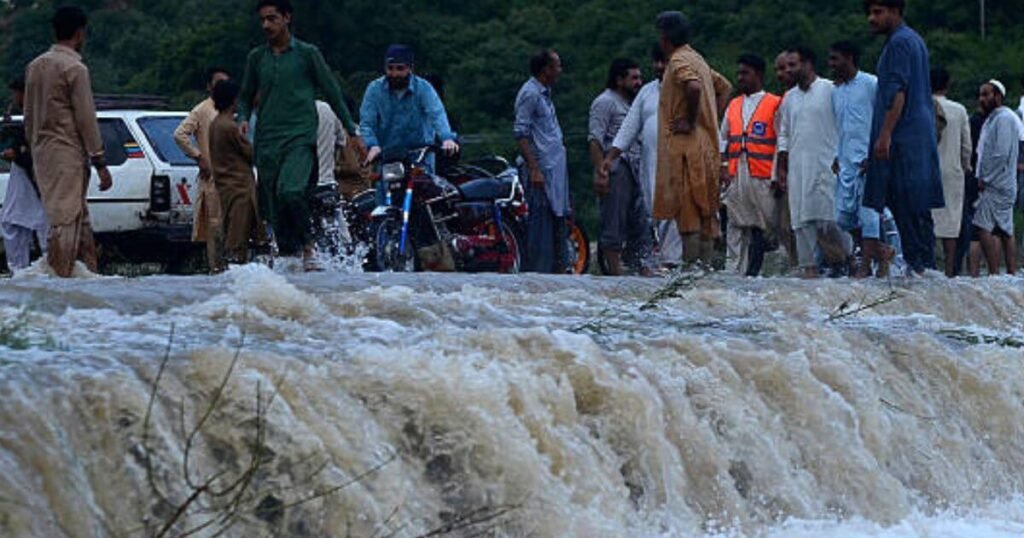The Ravi River Floods have struck Punjab with alarming speed, pushing authorities into emergency evacuation efforts. Monsoon rains, glacial melt, and unexpected India dam releases have turned Pakistan’s rivers into surging threats. The province—already bracing for climate shocks—faces infrastructure damage, agricultural damage, and rising urban flooding in vital areas like Lahore and Kasur. Amid soaring water levels, the National Disaster Management Authority (NDMA) and Provincial Disaster Management Authority (PDMA) are spearheading rescue operations and managing dozens of relief camps. The scope of this crisis underscores the urgent need for robust disaster preparedness. Stay tuned as we explore how communities, authorities, and volunteers are fighting back against this watery siege.
For more latest news checkout, Pakistan coverage.
Monsoon Deluge and Cross-Border Water Release
Monsoon rains have battered Pakistan harder than most recall, pushing Punjab floods into a crisis zone. Glacial melt has intensified the burden on the Ravi River, Chenab, and Sutlej, filling riverbeds faster than ever. Worse still, India dam releases—especially from the Thein dam at 97 percent capacity—have unleashed torrents toward Pakistan. These waters, a mix of meltwater and monsoon deluge, threaten the fertile lands of Punjab’s agricultural heartland. Officials from the NDMA and PDMA warn that Ravi River Floods pose an immediate danger, raising alarms across district administrations.
High-Flood Alerts and River Conditions
Ravi River at Jassar
The Ravi River at Jassar is surging fast. Levels rose from around 111,000 cusecs to over 115,000, with warnings of a leap toward 150,000 cusecs within 24 hours. The NDMA paints a dire picture: high flood levels are knocking at the door as repeated water releases and ongoing monsoon rain combine. Districts along the river face urgent evacuation efforts and reinforced alert status.
Sutlej River at Ganda Singh Wala
Over at Ganda Singh Wala, the Sutlej River is heaving with water. Flow rates have shot past 195,000 cusecs, signaling a high flood level. Parts of Bahawalnagar, Minchinabad, and Arifwala bear the brunt, with crops swept away and entire villages submerged. Authorities warn that this rise is part of a broader cross-border water management nightmare.
Chenab River at Marala Headworks
The Chenab is no less menacing. At Marala Headworks, the river surged past 400,000 cusecs, nearing severe flood status. This is dangerous for downstream infrastructures like Khanki and Qadirabad. The headwaters’ pressure spells trouble for rural connectivity and tough times ahead for crop areas that feed millions.
Mass Evacuations and Relief Efforts
Punjab’s scale of displacement is staggering. Reports confirm more than 150,000 people evacuated, some sources citing up to 190,000 relocated amid the ongoing deluge. Villages near the Ravi, Chenab, and Sutlej are especially impacted. Evacuations spread from Bahawalnagar, Kasur, Okara, Vehari to Pakpattan and beyond. In Narowal, sixteen villages stand at risk. Rescue operations led by the army, NDMA, PDMA, and Rescue 1122 are orchestrated round-the-clock. Relief camps now host displaced families with food, clean water, tents, and sanitation. The Prime Minister has personally ordered fast-tracked aid delivery.
To get all the latest news, click here.
Meteorological Forecast and Ongoing Risks

The monsoon refuses to loosen its grip. Forecasts predict heavy downpours in northeast Punjab and Kashmir, with urban flooding threatening Lahore, Rawalpindi, Gujranwala, and Gujrat. Hilly regions may face landslides from glacial melt–fed torrents. Meanwhile, infrastructure damage is mounting: collapsed bridges, breached dykes, broken roads. District officials warn residents to brace for more flood warnings as the cascading waters refuse to relent (view more).
Public Safety Advisory
You need to stay safe. Avoid low-lying areas near the Ravi River and other swollen rivers. Don’t travel unless necessary. Keep emergency kits ready and stay tuned to alerts from NDMA and PDMA. Social media, radio, and the NDMA app are critical for updates. If you are near Shahdara or Jassar, seriously consider relocation. Always follow instructions from local authorities—they know the situation on the ground best.
Frequently Asked Questions (FAQs)
1. What causes the Ravi River Floods in Punjab?
Heavy monsoon rains, accelerating glacial melt, and India dam releases—especially from Thein and Madhopur dams—have caused the Ravi River to surge to dangerous levels.
2. How many people have been evacuated due to the floods?
Authorities report that over 150,000 to 190,000 residents across Punjab have been evacuated from low-lying and vulnerable zones.
3. What is the role of the NDMA and PDMA in this crisis?
The National Disaster Management Authority (NDMA) and Provincial Disaster Management Authority (PDMA) are coordinating rescue operations, issuing flood warnings, and organizing relief camps and emergency response teams.
4. Are floods affecting the Sutlej and Chenab rivers as well?
Yes. The Sutlej at Ganda Singh Wala and the Chenab at Marala Headworks are also experiencing medium to high flood levels, intensifying the overall flood risks in Punjab.
5. Have the army and other forces been deployed?
Yes. The army, along with Rescue 1122, police, and civil defense units, are mobilized in districts like Lahore, Kasur, Sialkot, Faisalabad, Narowal, Okara, and Sargodha to assist evacuations and relief efforts.
Conclusion
The Ravi River Floods are no ordinary crisis. A deadly mix of relentless monsoon rain, melting glaciers, and India dam releases has turned Punjab’s lifeline rivers into threats. From the Chenab to the Sutlej, and especially the dangerous rise at Ravi, Punjab’s agricultural heartland teeters on the edge. Yet, amid this, evacuation operations, rescue operations, and coordinated efforts offer hope. Staying informed, cautious, and cooperative is key. The days ahead remain unpredictable, but strong community resilience and swift emergency response can help navigate this storm.
To Get all the news and updates from Pakistan, click here.








